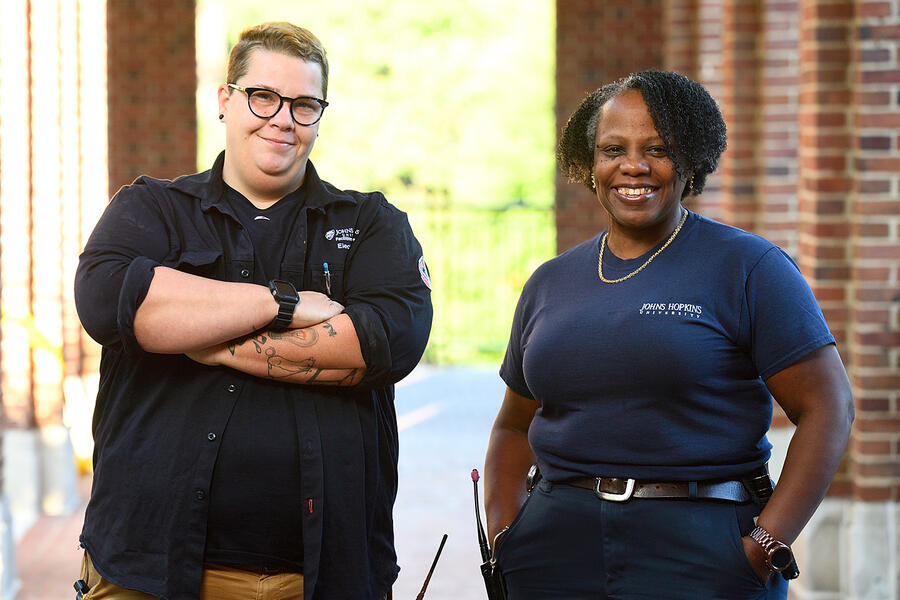Valerie Johnson doesn't think there's anything remarkable about her or her job. She may be the only one who thinks so. Hired as the university's first and only female plumber almost 30 years ago, she is still the only female plumber on staff with Johns Hopkins Facilities and Real Estate (often called "Jeffrey" for its acronym, JHFRE). She is part of the Facility Operations team that provides day-to-day maintenance for all the nonhousing buildings on the Homewood campus.
When she was hired, "They told my supervisor, Mr. Bruce, 'You better know what you're doing, hiring a female. If this doesn't work out, it's on you,'" Johnson recalls. "Maybe they thought I was there to stir things up."
In 2021, the number of women working in the skilled trades reached the highest level ever, at more than 314,000, according to the U.S. Department of Labor. The number of female apprentices more than doubled from 2014 to 2022, with women composing nearly 14% of active apprentices. But women still make up only a small percentage of tradespeople.
While female employees are still rare in Facility Operations, which also employs groundskeepers, painters, carpenters, roofers, and custodians, over the years Johnson has been joined by other tradeswomen, including Tiiu Maiste, hired about two years ago as the first and currently only female electrician on staff at JHFRE.
Maiste came to the profession after dropping out of high school and earning her GED. "I really wanted to do something in the trades. Electrical was a no-brainer because [electricity] was the reason our house burned down." In 2011, Maiste's family was living in a big, old house in Baltimore City when faulty wiring caused a fire in a bedroom. Her mother broke both ankles jumping to safety out of the third story. The rest of the family was OK, except for two dogs lost in the fire. That traumatic experience drove Maiste to want to learn how to prevent the same thing from happening to other people.
Johnson took a less direct path to her career in plumbing. After high school in New York, she took a job doing clerical work for a law firm on Wall Street. An ad in the newspaper for a program called Nontraditional Employment for Women caught her attention. The program trained and placed women in careers in the construction, utility, and maintenance trades. "I don't really know what appealed to me about it," she says. She just knew that a desk job wasn't for her.
Johnson worked alongside older women during her five-year apprenticeship, so she didn't consider herself unusual until she moved to Maryland. Women were fairly prevalent in the trades in New York at that time, she says. In Baltimore, however, she was an anomaly. "People were like, A female plumber? That's unheard of!"
By then, with several years of experience under her belt, Johnson had figured out how to make her way in a male-dominated profession. "I just kind of kept to myself." Even when she has been surrounded by coarse language, she says with a chuckle, "very rarely will you hear me curse. That's never been me." Fortunately, she says, she has mostly been treated well during her career. "I feel like what I put out was what I got back."
Maiste, however, says that before joining JHFRE she regularly endured poor treatment from male colleagues during her training and jobs. The bad behavior ranged from ignoring her questions, to vulgar speech intended to make her uncomfortable, to outright bullying and sabotage of her work. "It's pretty rough out there," she says, adding, "I have a lot of pride that I got myself through it. But it did take a mental health toll on me." Getting out of that toxic environment is what drove her to seek employment at Johns Hopkins.
Working at Johns Hopkins had always been a dream of hers, Maiste says, because of a teacher at her apprenticeship school, Al Bankard. "He worked here, and I thought very highly of him. He talked about his experiences here, so it's always been in the back of my head."
She continues, "At my previous job, it wasn't very inclusive or diverse. And I knew Hopkins really focused on that. I thought I would be a lot happier here, and it's true."
Maiste is not alone in her past job experiences. The Institute for Women's Policy Research noted in a 2022 briefing paper, "While tradeswomen have made much progress in recent years, too many, particularly women of color, face discrimination in hiring and employment and experience sexual harassment and gender or racial bias on the job. Women are less likely to be retained on core crews, promoted to field leadership positions, or to receive the same on-the-job technical training as men."
Johnson also was drawn to Johns Hopkins, all those years ago, because of its attention to diversity and inclusion. She saw a help wanted ad in The Baltimore Sun that read something like, Plumber needed. Minorities are encouraged to apply, she recalls. "So that's what really caught my eye. I felt encouraged, and I applied."
There's no such thing as a typical day on the job for either Johnson or Maiste. As a maintenance shop, their department receives work tickets submitted through an online ticketing system by anyone who has an issue. The Facility Operations team meets each morning to prioritize the requests.
For Johnson, a day's work could include anything from fixing a faucet to running gas lines to a lab. Maiste might find herself repairing a light switch that isn't working or "big stuff, like a huge main breaker for a building goes out and then we have to suit up and do some 13,000-volt switching." No two days are the same.
When asked what she likes best about her job, Johnson thinks for only a moment before she replies, "I like the people. You're always out and about, going to different buildings, and you get to know different people." In 30 years, she's certainly gotten to know a lot of people. But she's not thinking about retirement just yet. "I guess I'll keep working as long as I can, God willing."
One of Maiste's favorite parts of her job at JHFRE is training apprentices. "Teaching these guys the way I wish I'd been taught brings me a lot of joy," she says. She'd like to see more women working in the skilled trades in the future—particularly in leadership roles. "I want to see these glass ceilings taken out so we can be not just in this trade but also in positions of power, managing and supervising."
There is a shortage of skilled tradespeople in the U.S. A recent industry report found that making the trades more welcoming to women is critical to reducing this labor gap. With their skill, determination, and perseverance, trailblazers Johnson and Maiste are setting an example for aspiring tradespeople in their professions.
Posted in News+Info
Tagged hr newswire, who does that?









